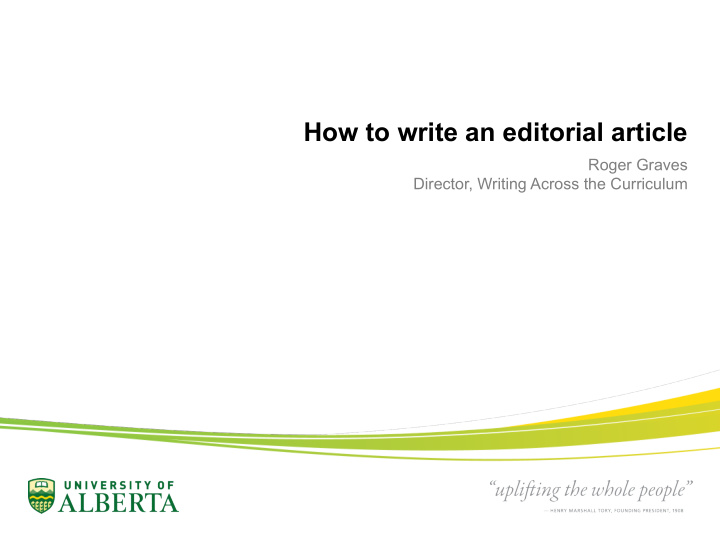



How to write an editorial article Roger Graves Director, Writing Across the Curriculum
Goals 1. Identify, describe and discuss the main theories and concepts in the sociology of development literature
Goals 2. Apply these theories to environmental issues, particularly in regards to unequal access to resources (including privileged discourses). 3. Relate outside reading and observations of the world around you to theories and concepts from the sociology of development.
Opinion editorial 2. Opinion editorial 25% +5% You are required to prepare a 500-800 words opinion editorial on a current environment and development topic (local or international). Please provide a supporting document showing your sources (e.g., newspapers, magazines, online sources, documentaries and academic texts). In this essay you will describe the issue and your stance on it, key values at stake; in the supporting document you will have an annotated list of at least seven sources. This is worth 25% of your grade and is due in class on Tuesday, December 2. In order to help you write a successful op-ed, you are required to submit a paragraph describing the topic and issue that you wish to explore in your paper, and identify and describe the major stakeholders supported by three references. The paragraph with 3 sources is worth 5% of your grade, and is due Tuesday October 21 in class.
Guidelines for Opinion editorial Please use the following format for Opinion editorial: • The editorial should be 500-800 words double-spaced, no title page; • Describe the issue (relevant history, current state of the debate, specific issue you wish to weigh in on); • Explain your position; • Use sources to inform your argument, not cited but with a list of at least 5 sources turned in with your essay. You should provide a brief (~150 word) recap of these sources. • Attempt to integrate theory into first version; must be included in second version. • Provide a byline (name, affiliation).
Opinion editorial as genre Connect to current events Announce a very specific topic & perspective Language is informal, journalistic Build an argument Use analogies Provide solutions http://www.udemy.com/blog/how-to-write-an-editorial/
Opinion editorial as genre Give concise background on issue Cite national trends to show support for your issue Localize the story Highlight political support for issue Get the right person to sign it. http://www.nrpa.org/Advocacy/Resources/How-to-Write-and-Place-an-Opinion-Editorial/
Opinion piece as persuasive essay 1. Research your topic 2. Know the facts and refer to them 3. Start with basic premise/theme 4. Use facts and details for backing 5. Leave readers with strong point 6. Don’t preach; help readers form their own opinions. https://sites.google.com/a/wjps.org/the-blazer---newspaper-class/opinion-editorial-writing/structure-of-an-editorial
Opinion editorial as genre 1. Generate interest: connect to current stories 2. Convey the structure of your piece 3. Connect to research; combine 2-3 sources 4. Humour is persuasive—try it. 5. Disclose your personal interest in topic 6. Keep it short: 500-800 words
http://www.universityaffairs.ca/why-students-struggle-with-writing.aspx
Explicit arguments Claim ¡ Reason ¡ Link ¡(because) ¡ Challenges ¡ ¡ Evidence ¡ (How, ¡So ¡what, ¡Why?) (Data, ¡Statistics, ¡Expert ¡opinion, ¡ Visuals, ¡Other ¡studies, ¡etc. ¡[What ¡ counts ¡is ¡often ¡discipline-‑speciCic]) Claim ¡+ ¡ stated ¡reason : ¡ ¡ Building ¡bigger ¡prisons ¡and ¡reducing ¡rehabilita5on ¡ programs ¡are ¡ineffec5ve ¡strategies ¡for ¡reducing ¡crime ¡ rates ¡ because ¡purely ¡puni3ve ¡ac3on ¡does ¡not ¡help ¡law ¡ breakers ¡change ¡the ¡behaviour ¡that ¡got ¡them ¡ incarcerated. ¡ ¡
Claims ¡and ¡Assump5ons ¡ • Claim + stated reason rest upon an unstated reason • Both the stated and unstated reasons rely on shared assumptions of value between the writer and the reader • Evidence demonstrates the validity of the stated or unstated reasons • When values are shared, less evidence is needed to convince the reader
Claim ¡+ ¡Stated ¡Reason ¡+ ¡Evidence ¡ • Evidence to support stated reason (Grounds) = facts, data, statistics, testimony (i.e., results from other research), examples • Backing = facts, statistics, testimony, examples that support the grounds or assumptions you are working from
Brainstorming Ideas for Opinion editorial: • Alternative conceptions of development • Food sovereignty
Thesis Topic into thesis http://www.artsrn.ualberta.ca/WAC/Resources/ TopicToThesis.html
Outlining 1. Intro: connect to current events 2. Summarize research, provide background 3. Give evidence, backing, political support 4. Leave readers with a strong point
Recommend
More recommend